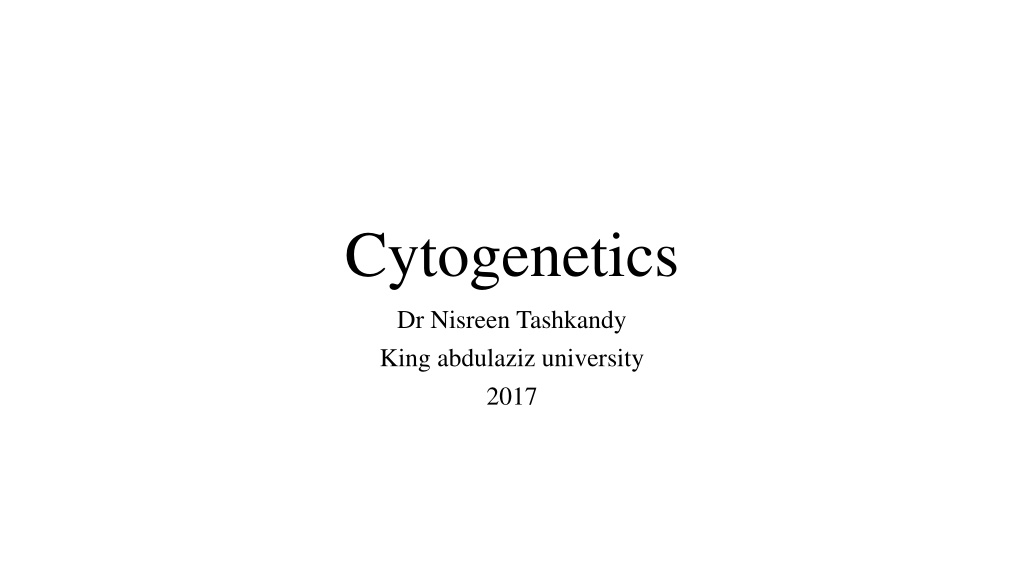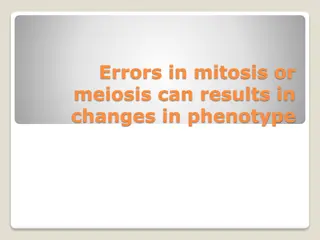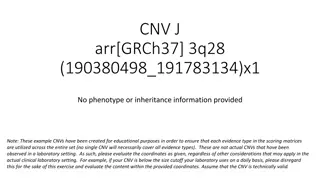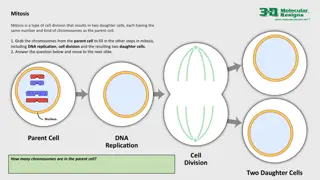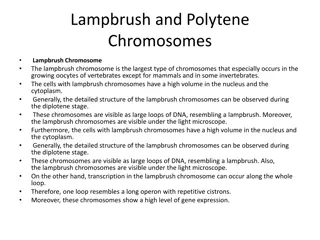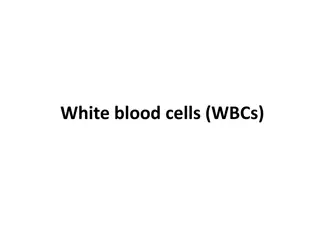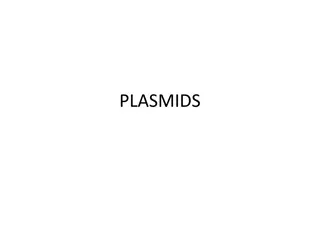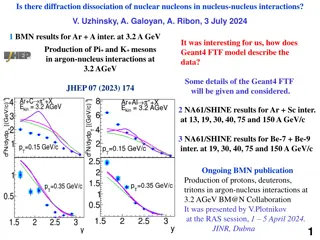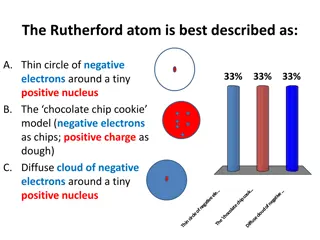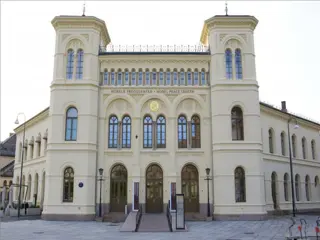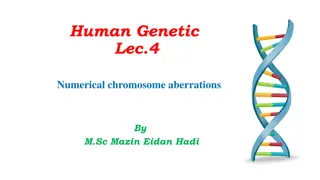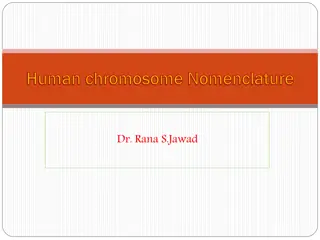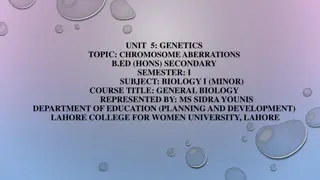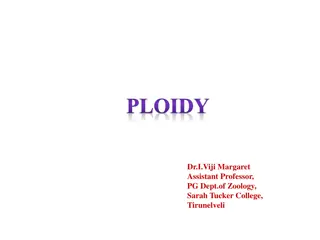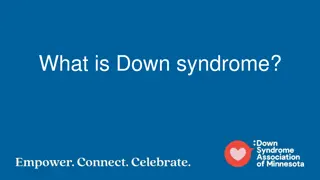Understanding Chromosome Territories in the Nucleus
Chromosome territories refer to specific regions in the nucleus where chromosomes are organized. While chromosomes appear as condensed structures during cell division, they have a different appearance in non-dividing cells like neurons. Scientists have used microscopy to study chromosome organization, revealing that chromosomes undergo structural changes between cell divisions. Early models, such as the chromosome territory model proposed by Carl Rabl, suggested that each chromosome occupies a distinct space in the nucleus.
Download Presentation

Please find below an Image/Link to download the presentation.
The content on the website is provided AS IS for your information and personal use only. It may not be sold, licensed, or shared on other websites without obtaining consent from the author. Download presentation by click this link. If you encounter any issues during the download, it is possible that the publisher has removed the file from their server.
E N D
Presentation Transcript
Cytogenetics Dr Nisreen Tashkandy King abdulaziz university 2017
Chromosome Territories: The Arrangement of Chromosomes in the Nucleus Chromosomes occupy specific regions of a nucleus, called "chromosome territories." These subdomains might be doing much more than just keeping everything organized
what do chromosomes look like in the nucleus of a cell between cell divisions? Chances are that when most people hear the word "chromosome," they picture a rodlike, highly compacted chunk of DNA. While chromosomes do appear as condensed, elongated structures during the process of cell division, for most of a cell's lifetime chromosomes do not look anything like this In some cell types, such as neurons, never undergo cell division, and their chromosomes therefore never take on a condensed state.
Determining How Chromosomes Are Organized was a technically challenging problem for scientists for many decades. One might think that it would be possible to simply use microscopes to peer into the nucleus and see how chromosomes are arranged. during the 1960s and 1970s, various approaches involving both electron and light microscopy showed that chromosomes undergo a dramatic structural change as cells transition from mitosis to interphase, and that these structures exist as decondensed structures between cell divisions.
How Chromosomes Are Organized However, microscopy did not reveal how chromosomes were organized in the nucleus of cells that were not undergoing mitosis. In fact, during the period between cell divisions, no distinct individual chromosomes can be recognized via either light or electron microscopy; thus, it is impossible to distinguish one chromosome from its neighbor using these methods.
The first Model of Chromosome Organization Despite a lack of direct observational evidence, early researchers proposed two models for the way in which chromosomes were likely organized in the nuclei of nondividing cells. The first model, known as the chromosome territory model, was originally proposed by Carl Rabl in 1885. According to this model, the DNA of each chromosome occupies a defined volume of the nucleus and only overlaps with its immediate neighbors (Figure 2Ab).
The second Modelof Chromosome Organization In contrast, according to the second or "spaghetti" model, the DNA fiber of multiple chromosomes roams through the nucleus in a largely random fashion, and the chromosomes are therefore intermingled and entangled with each other (Figure 2Be)
Testing the Models The key experiment to distinguish between these two models was eventually carried out in the early 1980s by Thomas Cremer, a German cell biologist, and his physicist brother, Christoph Cremer. The Cremers realized that the two models made very distinct predictions and could thus be distinguished from each other if it were somehow possible to mark chromosome regions in part of the nucleus and follow the fate of these regions during cell division.
Testing the Models Specifically, the Cremers argued that if chromosomes existed in territories occupying only a limited volume in the nucleus, marking of a defined volume would only affect very few immediately adjacent chromosomes (Figure 2Aa). On the other hand, if the spaghetti model were correct, the marking of a small volume would affect a large number of chromosomes, because fibers from many different chromosomes would be running through the marked volume (Figure 2Bd).
Testing the Models To carry out this significant experiment, Christoph Cremer and his group developed a laser that could be focused very narrowly to shine on a small section of a cell's nucleus. The laser light was of a wavelength that induced DNA damage in the illuminated regions. The Cremers then oppressed the ability of cells to repair damaged DNA by providing radioactively labeled nucleotides, which the cell incorporated into its DNA during the repair process. Then, when the cell entered the next mitosis and its chromosomes took on a condensed appearance, the marked regions were analyzed by radiography.
Testing the Models The results were clear. The Cremer brothers found that only a few chromosomes per cell were damaged, a result that strongly supported the chromosome territory model. The existence of chromosome territories was impressively confirmed a few years later by the development of the fluorescence in situ hybridization (FISH) technique, in which fluorescently labeled probes complementary to a specific chromosome are used to visualize a given chromosome in the intact nucleus. These experiments allowed direct visualization of the territorial nature of chromosomes (Figure 3).
A) Chromosome territories (green) in liver cell nuclei (blue). B) Visualization of multiple chromosomes reveals spatial patterns of organization. Chromosomes 12 (red), 14 (blue), and 15 (green) form a cluster in mouse lymphocytes.
Are chromosome territories randomly arranged in the nucleus, or they are they organized into patterns? Two experiments demonstrate that chromosomes are not randomly localized within the nucleus. First, when researchers measure the distance of a given chromosome from the center of a cell's nucleus, they note that some chromosomes localize toward the periphery, often touching the nuclear membrane, whereas others are located toward the center of the nucleus. Second, when visualizing multiple chromosome territories, scientists tend to see recurrent clusters of chromosomes. For example, in mouse lymphocytes, chromosome 12 often sits next to chromosome 14, which in turn is adjacent to chromosome 15, thereby forming a triplet cluster
Are chromosome territories randomly arranged in the nucleus, or they are they organized into patterns? Researchers have also examined whether various findings related to chromosomal territories hold true across species. Through such studies, scientists have noted that there are large areas of chromosomal identity between different species that have been maintained throughout evolution; moreover, these areas of identity maintain their positions in different species (Tanabe et al., 2002). Indeed, analysis of chromosome territories in many cell types and tissues has made it clear that patterns of chromosome arrangement are specific to both cell type and tissue type
the connection between chromosomal territories and disease Yet another interesting observation has been the finding that chromosome territories can reposition in disease, which might provide novel insights into disease mechanisms and why genes are incorrectly expressed in disease. In fact, scientists have manipulated the localization of chromosomes and seen some changes in gene expression as a result, thus suggesting a possible mechanism for the connection between chromosomal territories and disease (Finlan et al., 2008).
Are chromosome territories randomly arranged in the nucleus, or they are they organized into patterns? researchers still have numerous questions about chromosome territories., for instance: to understand what mechanisms determine exactly where a chromosome ends up in the nucleus. As of July 2008, no proteins have been identified that either anchor chromosomes in the nucleus or link multiple chromosomes to each other to establish chromosome clusters. As research continues, perhaps these and other questions will eventually be answered
